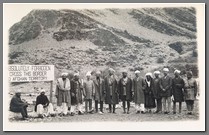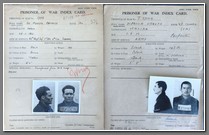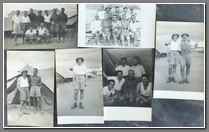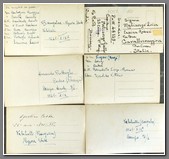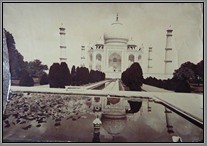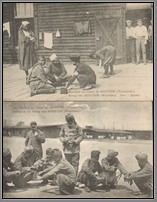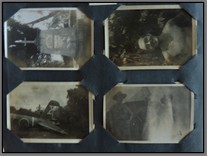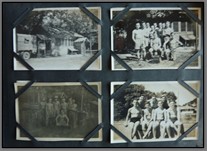Photos and Postcards
Photo album from a British soldier named Reginald, with the RACON section (radar beacon) of the 9th Battalion of the York and Lancaster Regiment based in East India. They were active in the Arakan War in Burma in 1942-1943 and in the battles in Southern Burma in 1944-1945. Shown are the memorial to the unit, the author standing atop a downed Japanese zero at Mingaladon, with his mates outside the RACON unit, numerous photos of Rangoon and Mandalay in 1945-1946, his billet at Maymo, Japanese POW’s clearing wreckage of one of their own fighters, new camp at Mergui, sitting atop a spitfire, more. 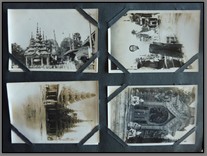 PHPC 092
PHPC 092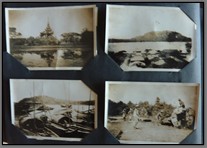 PHPC 09249 photos in all, none missing, many with captions on reverse. All photos tipped in. M
PHPC 09249 photos in all, none missing, many with captions on reverse. All photos tipped in. M
Price: $600.00
Note: The 9th Battalion was raised in 1940, after being stationed in Northern Ireland with the 71st Brigade from 1940 to 1942. They were sent to India in 1942 where they joined the 25th Indian Infantry Division, part of the 53rd Indian Infantry Brigade. The battalion took a significant part in the Arakan battles of 1942–1943 and in the battles for southern Burma in 1944 to 1945.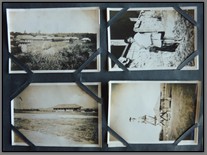 PHPC 092
PHPC 092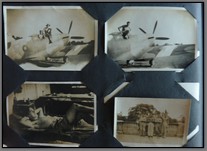 PHPC 092
PHPC 092
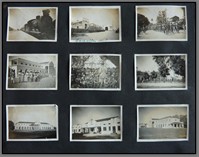 PHPC 091
PHPC 091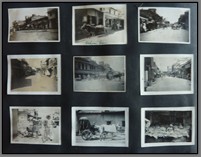 PHPC 091Photo album belonging to a British soldier based in Bareilly India and then Chak Rata in the Himalayas and then Allahbad, all between April-July, 1942. He was with the RAF 23rd WOU (Wireless Observance Unit). His unit arrives in Bombay in April, 1942. Shown are the Tehsil bazaar, Moti Park bazaar, British military hospital, B.I. bazaar, town hall, prison and police headquarters, the 23rd WOU marching to 15 Clyde barracks, Indian and British troops together, transporting dead, native life, Sahiya Station, Chak Rata, mountain tribe at Chak Rata, military barracks in the Himalayas, including “MacMullens cinema”, McPhersons Barracks at Allahabad in July, wash house at Bamrouli, thatched roof built over a tent to protect from the heat, local road building.
PHPC 091Photo album belonging to a British soldier based in Bareilly India and then Chak Rata in the Himalayas and then Allahbad, all between April-July, 1942. He was with the RAF 23rd WOU (Wireless Observance Unit). His unit arrives in Bombay in April, 1942. Shown are the Tehsil bazaar, Moti Park bazaar, British military hospital, B.I. bazaar, town hall, prison and police headquarters, the 23rd WOU marching to 15 Clyde barracks, Indian and British troops together, transporting dead, native life, Sahiya Station, Chak Rata, mountain tribe at Chak Rata, military barracks in the Himalayas, including “MacMullens cinema”, McPhersons Barracks at Allahabad in July, wash house at Bamrouli, thatched roof built over a tent to protect from the heat, local road building. PHPC 091
PHPC 091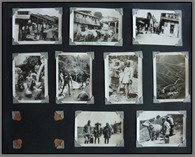 PHPC 091 160 photos, some tipped in so you can read captions on reverse. 11 photos have fallen out over time and are absent. The value of this album is that it traces the path and life of one of the very scarce RAF WO units. The unit was loosely attached to the 34th Squadron, which was based in Chak Rat from April 1-5 and in Allahabad from April 17-June 1942. B
PHPC 091 160 photos, some tipped in so you can read captions on reverse. 11 photos have fallen out over time and are absent. The value of this album is that it traces the path and life of one of the very scarce RAF WO units. The unit was loosely attached to the 34th Squadron, which was based in Chak Rat from April 1-5 and in Allahabad from April 17-June 1942. B
Price: $1100.00
Note: Following the fall of Burma in the Spring of 1942, great efforts were made to equip India with an efficient defense system which included radar, 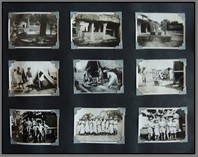 PHPC 091
PHPC 091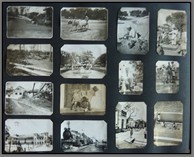 PHPC 091supported by an Observer Corps and the formation of Wireless Observer Units, both of which would fill gaps in the radar chain. In April 1942 early warning units were beginning to arrive in India and Ceylon. The main fear at the time was a Japanese attack on Calcutta. This album covers what I think is the only WO unit based in the Himalayas to protect from an attack from the north.
PHPC 091supported by an Observer Corps and the formation of Wireless Observer Units, both of which would fill gaps in the radar chain. In April 1942 early warning units were beginning to arrive in India and Ceylon. The main fear at the time was a Japanese attack on Calcutta. This album covers what I think is the only WO unit based in the Himalayas to protect from an attack from the north.
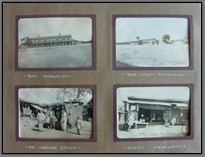 PHPC 090
PHPC 090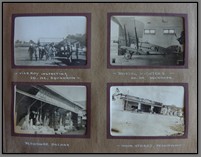 PHPC 0901928 - 1929 photo album containing 90 unique original real photographs taken by air observer and reconnaissance airman Ronald Malloy of 20 (A.C.) Squadron C flight. Six photos have fallen out over time.
PHPC 0901928 - 1929 photo album containing 90 unique original real photographs taken by air observer and reconnaissance airman Ronald Malloy of 20 (A.C.) Squadron C flight. Six photos have fallen out over time.
Malloy was an accomplished photographer because his photos, many of them taken from his bi-plane are well composed and clear. If you look carefully on some of them you can see where he's marked the coordinates for artillery fire if it became necessary. 20 (A.C.) Squadron was mainly a reconnaissance squadron used for information and calling in artillery fire although they did sometimes take part in combat and of course the Kabul Evacuation.
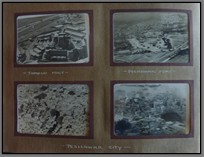 PHPC 090
PHPC 090 PHPC 090These photographs were taken during the period of the Kabul and Peshawar troubles of 1928 and 1929. This was also the squadron that took part in the first ever large scale mercy flight.
PHPC 090These photographs were taken during the period of the Kabul and Peshawar troubles of 1928 and 1929. This was also the squadron that took part in the first ever large scale mercy flight.
The world's first ever major 'mercy airlift' was carried out from Kabul in Afghanistan to Peshawar in Northern India (now Pakistan), North Western Frontier Province. (NWFP), over the Suleiman mountains in the snowbound winter of 1928-29, using DC5s for reconnaissance, and Vickers Victorias and one Handley-Page to evacuate all the European embassy staffs - 'women and children first': not a single life was lost.
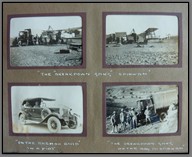 PHPC 090
PHPC 090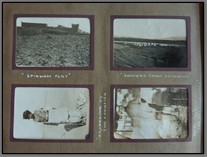 PHPC 090Using only fragile biplanes the RAF saved Kabul's entire diplomatic community from the jaws of a violent tribal revolt. Held aloft by little more than canvas, wood and wire, pilots braved freezing temperatures and snowy 10,000ft mountains that offered nowhere for a forced landing. And over two months they rescued nearly 600 civilians and flew the equivalent of twice around the world without losing, or taking, a single life. The evacuation began with King Amanullah's ill-advised attempts to reform his deeply conservative subjects. Shown are aerial views of government house, RAF compound in Peshawar, Viceroy inspecting 20th AC Squadron, main street in Peshawar, Bristol fighter planes, Hindu merchants, aerial views of a number of forts and cities, married and mens quarters in Cherat, several photos of Miranshah Fort, a hilltop blockhouse in Waziristan, several photos of Jhikagali, repairing an airplane at Spinwam. The last photo is a photo of Malloy himself. A very well captioned album with very clear photos. M
PHPC 090Using only fragile biplanes the RAF saved Kabul's entire diplomatic community from the jaws of a violent tribal revolt. Held aloft by little more than canvas, wood and wire, pilots braved freezing temperatures and snowy 10,000ft mountains that offered nowhere for a forced landing. And over two months they rescued nearly 600 civilians and flew the equivalent of twice around the world without losing, or taking, a single life. The evacuation began with King Amanullah's ill-advised attempts to reform his deeply conservative subjects. Shown are aerial views of government house, RAF compound in Peshawar, Viceroy inspecting 20th AC Squadron, main street in Peshawar, Bristol fighter planes, Hindu merchants, aerial views of a number of forts and cities, married and mens quarters in Cherat, several photos of Miranshah Fort, a hilltop blockhouse in Waziristan, several photos of Jhikagali, repairing an airplane at Spinwam. The last photo is a photo of Malloy himself. A very well captioned album with very clear photos. M
Price: $800.00
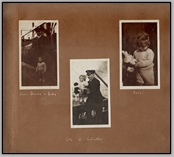 PTO 309Album of 300 photographs that dates from the 1920’s taken in India by Dr. Gladys Rutherford. She was part of The Baptist missionary society in England, a pioneer in Tropical medicine, was in charge of The Lady Harding Hospital at Dholphur Rajputana and in 1955 was the very first recipient of the John Holt Medal, awarded for meritorious work in tropical hygiene in India by the Liverpool School of Topical Medicine.
PTO 309Album of 300 photographs that dates from the 1920’s taken in India by Dr. Gladys Rutherford. She was part of The Baptist missionary society in England, a pioneer in Tropical medicine, was in charge of The Lady Harding Hospital at Dholphur Rajputana and in 1955 was the very first recipient of the John Holt Medal, awarded for meritorious work in tropical hygiene in India by the Liverpool School of Topical Medicine.
The album covers the period where she arrived in India, to her patients, staff, 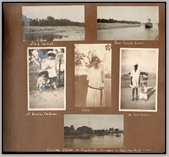 PTO 309nurses, orphans, the Kellogg non-conformist Church, doctors, hospitals, lepers, Christian converts, various Indian religious festivals, processions, nomads, elephants. Interesting photo of women using spinning wheels with the caption: "Spinning wheel as insisted upon by Gandhi." Dr. Rutherford is shown in many photos and there are photos of an eye clinic as well as an interesting and rare photo of H.H. Maharaja Rana and H. E Viceroy Lord Irwin. Locations mentioned are Bhiwani, Saiyan, Agra, Sonamarg, Kashmir, Moga Eye Hospital, Machkund, Pompei Suez, Shimla Hiills Taj Mahal, Lansdown Language School.
PTO 309nurses, orphans, the Kellogg non-conformist Church, doctors, hospitals, lepers, Christian converts, various Indian religious festivals, processions, nomads, elephants. Interesting photo of women using spinning wheels with the caption: "Spinning wheel as insisted upon by Gandhi." Dr. Rutherford is shown in many photos and there are photos of an eye clinic as well as an interesting and rare photo of H.H. Maharaja Rana and H. E Viceroy Lord Irwin. Locations mentioned are Bhiwani, Saiyan, Agra, Sonamarg, Kashmir, Moga Eye Hospital, Machkund, Pompei Suez, Shimla Hiills Taj Mahal, Lansdown Language School.
 PTO 309Included is a portrait of Dr. Rutherford measuring 8" x 6" housed in a pocket at the rear. There are also 4 postcards written by Dr. Rutherford as well as a magazine article found in the album featuring a letter from Dr. Rutherford while at the Lady Harding’s Hospital at Rajputanna dated 1926 " Princes Gate Church Magazine
PTO 309Included is a portrait of Dr. Rutherford measuring 8" x 6" housed in a pocket at the rear. There are also 4 postcards written by Dr. Rutherford as well as a magazine article found in the album featuring a letter from Dr. Rutherford while at the Lady Harding’s Hospital at Rajputanna dated 1926 " Princes Gate Church Magazine
Extract from her letter:
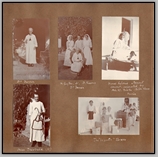 PTO 309Lady Hardinge Hospital, Dholphur, Rajputana,March 17th, 1926. My Dear Backers-up, It is very long time since I wrote to you, but still I get news from time to time, which shows me that you are still remembering and keeping your enthusiasm. The year in Bhiwani was a very heavy one and letter writing was reduced to a minimum. Language study was given up, but the closer work among the patients and nurses helped me on very much with my conversation.
PTO 309Lady Hardinge Hospital, Dholphur, Rajputana,March 17th, 1926. My Dear Backers-up, It is very long time since I wrote to you, but still I get news from time to time, which shows me that you are still remembering and keeping your enthusiasm. The year in Bhiwani was a very heavy one and letter writing was reduced to a minimum. Language study was given up, but the closer work among the patients and nurses helped me on very much with my conversation. 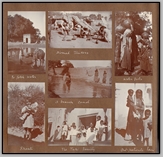 PTO 309I had to give lessons to the nurses in Hindustani on anatomy and midwifery and in that way my vocabulary was increased in directions which proved more useful than if I had studied his Indian history, which were set for second language examination.
PTO 309I had to give lessons to the nurses in Hindustani on anatomy and midwifery and in that way my vocabulary was increased in directions which proved more useful than if I had studied his Indian history, which were set for second language examination.
At the beginning of May a man came to the out-patient hall caring a baby girl about twelve months old. A very thin, miserable little scrap she was. He said her mother had died and that he was out of work. For the last three months he had been looking for the baby and had fed her on goats milk but she was not at all well. A well described photo album of an important female pioneer in the field of tropical disease prevention. UNAVAILABLE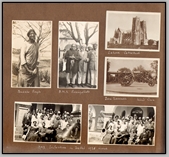 PTO 309
PTO 309
Price: $1400.00
Note: Dr. Rutherford, M.B., Ch.B., D.T.M., a native of Liverpool, was called to the mission field in 1923, serving in India at Bhiwani (1923-1925) and then at Dholpur. The 142nd Annual Report of the Baptist Missionary Society, dated March 31, 1934, states ‘From the Women’s hospital in the Indian state of Dholpur comes the news that the authorities of the State have been providing additional quarters for the nursing staff and a few private wards which will materially assist the work which Dr. Rutherford and her colleagues are carrying on in that State Institution’.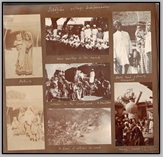 PTO 309 The same report also lists the Brighton and Hove Auxillary as Dr. Rutherford’s chief supporter. Her missionary assistant was Abdul Rahim. The 1936 report writes ‘The hospital at Dholpur belongs to the State, and the cost of maintenance is borne entirely by it. This year a new and beautiful wing has been added, and the hospital is now called the Sri Mahrani Kesar Memorial Hospital. Dr. Rutherford has been in charge, and a year of successful work is reported.
PTO 309 The same report also lists the Brighton and Hove Auxillary as Dr. Rutherford’s chief supporter. Her missionary assistant was Abdul Rahim. The 1936 report writes ‘The hospital at Dholpur belongs to the State, and the cost of maintenance is borne entirely by it. This year a new and beautiful wing has been added, and the hospital is now called the Sri Mahrani Kesar Memorial Hospital. Dr. Rutherford has been in charge, and a year of successful work is reported.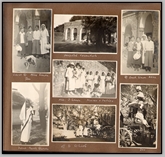 PTO 309
PTO 309
In the 1953 report from UNESCO on the Messina Seminar on the Use of Visual Aids in Fundamental Education, it says ‘Dr. Gladys Rutherford of the India Village Service in United Provinces, India, is doing some noteworthy work in health education. About two years ago, she asked for help and co-operation in the development of story materials to accompany the flashcards, filmstrips and flannelgraphs which she has developed. These delightful visual devices, now so familiar to villagers throughout India, features stick figure characters which she calls ‘jets’ (because they are black) and which are, in India, perhaps as popular as the famous Walt Disney cartoons. The stick figure here is named ‘Ganpat’. Accordingly, using the outline of ‘talking points’ which accompanies each set of the ‘jet’ series of flashcards, a simple story was developed. 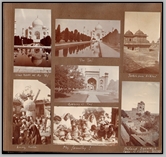 PTO 309It happened that the set used was the one concerning tuberculosis. However, Dr. Rutherford was not at hand at the time the story was developed.
PTO 309It happened that the set used was the one concerning tuberculosis. However, Dr. Rutherford was not at hand at the time the story was developed.  PTO 309It was necessary to use an artist who was available locally to make the illustrations for the experiment; for since the story episodes had to be related in logical sequence which could not depend upon a commentator’s interjecting additional information, more pictures were needed than were included in the ‘jet’ series. And – what might seem odd – the delightful simplicity of the ‘jets’ made it difficult for the local artist to make plausible reproductions to fill in the gaps. However, he was so intrigued by ‘Ganpat’, the ‘Jet’, that almost involuntarily, he found himself interpreting ‘Ganpat’ in his own way.
PTO 309It was necessary to use an artist who was available locally to make the illustrations for the experiment; for since the story episodes had to be related in logical sequence which could not depend upon a commentator’s interjecting additional information, more pictures were needed than were included in the ‘jet’ series. And – what might seem odd – the delightful simplicity of the ‘jets’ made it difficult for the local artist to make plausible reproductions to fill in the gaps. However, he was so intrigued by ‘Ganpat’, the ‘Jet’, that almost involuntarily, he found himself interpreting ‘Ganpat’ in his own way.
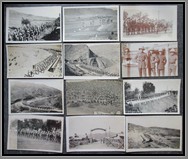 PHPC 08721 PHOTOS KINGS ROYAL RIFLES CORPS, March from RAWALPINDI to RAZMAK 1926. The 1st Battalion, The King’s Royal Rifle Corps, moved from Ireland to India in 1922 and, after three years stationed at Rawalpindi, was ordered to the Razmak district of North Waziristan on the North-West Frontier bordering Afghanistan. At 8.20 a.m. on 16 November 1926, 14 officers and 618 other ranks, under the command of Lieutenant-Colonel F.G. Willan CMG DSO, marched out of their barracks in Rawalpindi en route to Razmak. Two officers and 80 other ranks accompanied the heavy baggage which was dispatched by train. It took the Battalion 22 days to complete the 262-mile march, arriving at Razmak in a snowstorm on 8 December.
PHPC 08721 PHOTOS KINGS ROYAL RIFLES CORPS, March from RAWALPINDI to RAZMAK 1926. The 1st Battalion, The King’s Royal Rifle Corps, moved from Ireland to India in 1922 and, after three years stationed at Rawalpindi, was ordered to the Razmak district of North Waziristan on the North-West Frontier bordering Afghanistan. At 8.20 a.m. on 16 November 1926, 14 officers and 618 other ranks, under the command of Lieutenant-Colonel F.G. Willan CMG DSO, marched out of their barracks in Rawalpindi en route to Razmak. Two officers and 80 other ranks accompanied the heavy baggage which was dispatched by train. It took the Battalion 22 days to complete the 262-mile march, arriving at Razmak in a snowstorm on 8 December. 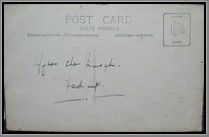 PHPC 087The average distance marched each day was 14 miles with three rest days. The greatest distance marched in a single day was 20 miles on 1 December.
PHPC 087The average distance marched each day was 14 miles with three rest days. The greatest distance marched in a single day was 20 miles on 1 December.
Setting an example to his men, the Commanding Officer marched the whole distance on foot stating that he was afraid that he might get stiff if he rode on his horse. The Battalion spent a year at Razmak seeking to prevent the Mahsuds and Wazirs from fighting. Razmak itself lies on a plateau 6,600 feet above sea level. The surrounding area is extremely rugged and mountainous. A British garrison was established at Razmak in 1922 to police the area, with battalions spending a year there at a time on what was effectively ‘active service’. In November 1927 the Battalion left Razmak and went to Lucknow. 12 real photos. M
Price: $220.00
 PTO 307 PTO 307 |  PTO 307 PTO 307 | 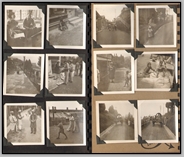 PTO 307 PTO 307 | 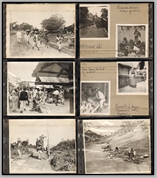 PTO 307 PTO 307 |
1945 photo album mostly from Margherita, Assam and also photos of Nepal and Sikhim. Shown are local life in Margherita, Assam with different identified shops in the native quarter. Some photos of the US 181st Signal Repair Company, which was based at Margherita. There are 90 original photos; most are 4 x 5 inches, and balance are 2 ½ x 2 inches. The larger photos have notes written on the back describing some of the locations and commentary on customs and people. Photos are housed in a leather bound volume that has a vintage metal ring binding mechanism that is somewhat frozen. B
Price: $390.00

